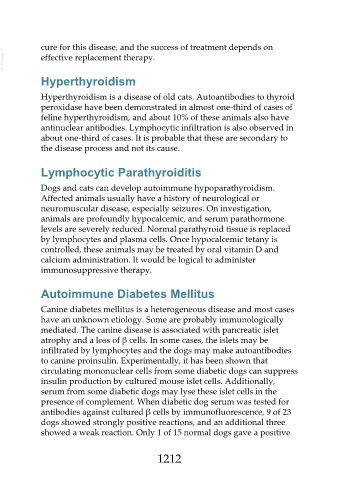Page 1212 - Veterinary Immunology, 10th Edition
P. 1212
cure for this disease, and the success of treatment depends on
VetBooks.ir effective replacement therapy.
Hyperthyroidism
Hyperthyroidism is a disease of old cats. Autoantibodies to thyroid
peroxidase have been demonstrated in almost one-third of cases of
feline hyperthyroidism, and about 10% of these animals also have
antinuclear antibodies. Lymphocytic infiltration is also observed in
about one-third of cases. It is probable that these are secondary to
the disease process and not its cause.
Lymphocytic Parathyroiditis
Dogs and cats can develop autoimmune hypoparathyroidism.
Affected animals usually have a history of neurological or
neuromuscular disease, especially seizures. On investigation,
animals are profoundly hypocalcemic, and serum parathormone
levels are severely reduced. Normal parathyroid tissue is replaced
by lymphocytes and plasma cells. Once hypocalcemic tetany is
controlled, these animals may be treated by oral vitamin D and
calcium administration. It would be logical to administer
immunosuppressive therapy.
Autoimmune Diabetes Mellitus
Canine diabetes mellitus is a heterogeneous disease and most cases
have an unknown etiology. Some are probably immunologically
mediated. The canine disease is associated with pancreatic islet
atrophy and a loss of β cells. In some cases, the islets may be
infiltrated by lymphocytes and the dogs may make autoantibodies
to canine proinsulin. Experimentally, it has been shown that
circulating mononuclear cells from some diabetic dogs can suppress
insulin production by cultured mouse islet cells. Additionally,
serum from some diabetic dogs may lyse these islet cells in the
presence of complement. When diabetic dog serum was tested for
antibodies against cultured β cells by immunofluorescence, 9 of 23
dogs showed strongly positive reactions, and an additional three
showed a weak reaction. Only 1 of 15 normal dogs gave a positive
1212

